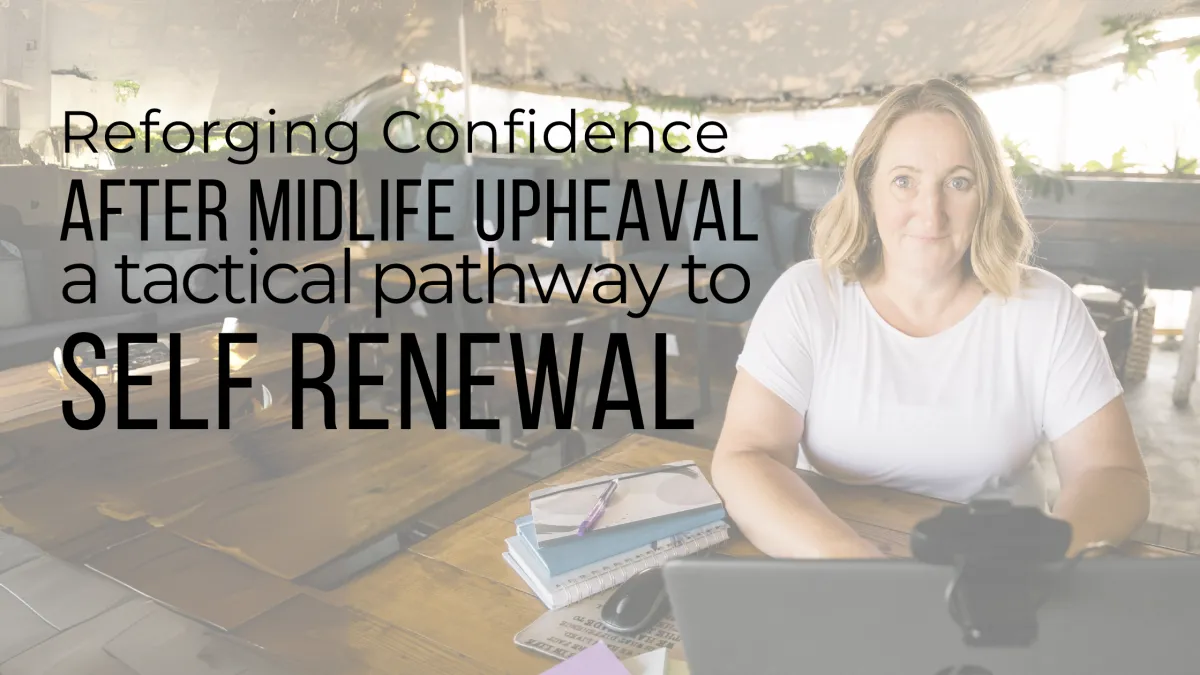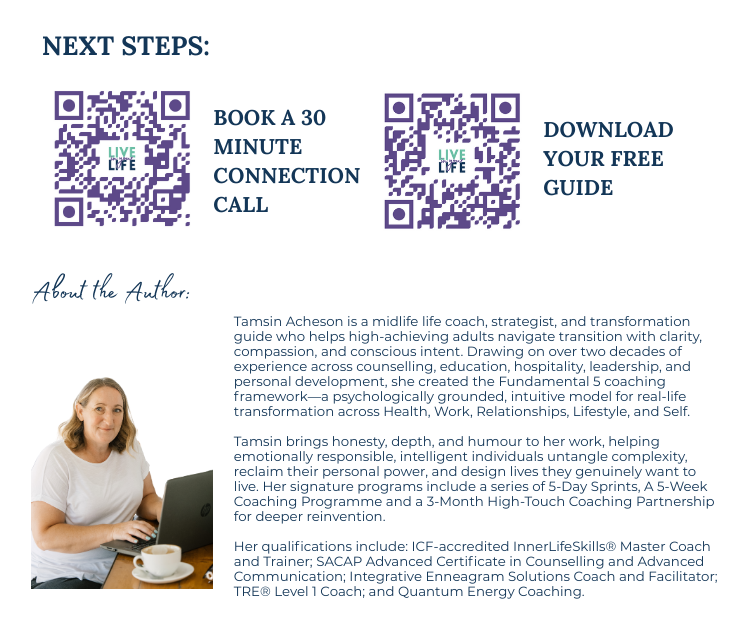
Reforging Confidence After Midlife Upheaval: A Tactical Pathway to Self-Renewal
Reforging Confidence After Midlife Upheaval: A Tactical Pathway to Self-Renewal
Why Does Confidence Crumble During Life’s Second Act?
Confidence doesn’t simply erode in midlife, it’s often hijacked. Not by drama, but by a relentless series of life’s heavier lessons. The career disappointments or redundancy, ruptured unions, shifting roles, degenerating health, caretaking burdens, and existential unease. Each one a subtle detonation beneath the scaffolding of our once-certain identity, and not the glamorous kind you walk away from in slow motion. More like the kaboom – whoops there goes another chunk of self-worth kind.
We don’t merely misplace belief in ourselves, we have front row seats to the dismantling of our former self, the one we leaned on for decades.
Cracking the Code of Collapse: Midlife Setbacks Decoded
A disruption at 47 doesn't echo the chaos of 27. By this point, our sense of self is deeply anchored in legacy, not just possibility. The shame-inducing mantra of “I should have arrived by now” collides head-on with modern pressures to stay agile, youthful, and ever-evolving.
These trials aren’t theoretical; they’re identity-shaking events. Careers that plateau or are forcibly concluded. Emotional estrangement in long-standing relationships. A physicality that no longer cooperates, or even operates, on occasion. Regret-soaked finances. Squandered opportunities and dreams. An eerie emptiness where purpose used to reside. The LinkedIn profile left untouched for months now reads more like an epitaph.
Am I painting an inspiring picture? No.
But it’s a true one.
Confidence in midlife isn’t just about how we see ourselves, it’s often about how we’ve been seen. When you’ve been wired (or rewarded) to be the fixer, the achiever, the caretaker, the one who delivers, losing your ‘usefulness’ can feel like losing your value.
For many, this unravelling is compounded by things we’re only just discovering: undiagnosed ADHD, trauma patterns, CPTSD - neurodivergent wiring that shaped how we coped, achieved, and performed. What once looked like high-functioning might now look like burnout, and when burnout hits, it doesn’t just exhaust your body - it fractures your self-trust.
So, now that what’s in the spotlight is gloriously illuminated, let’s see what can be done about it.
Phase One: Radical Acceptance
Usually awareness is the first step, but when it comes to losing confidence and plunging into a pit of self-doubt and powerlessness, the identification phase is generally quite blatant and unmissable!
Try this: Say it out loud. "This is where I am. This is what happened. And I am still here."
We need to wrestle our authority back through unfiltered acceptance. Not just the things that are easier to accept (like the bits we can attribute to the input of others), but all of it.
This is not apathy or resignation. It is not a passive surrender. It is a deliberate declaration. We need to own that wreckage without wrapping it in a blanket of shame.
It occurred. You endured it. Now you get to decide where you put your feet.
When we cease resisting the truth of our moment, power returns to our palms. We begin not with a leap, but with stillness. Confidence cannot bloom where denial saturates the soil.
Phase Two: Mute the Heckler, Meet the Author
Our internal script is rarely neutral. More often, it’s a relentless heckler, taking advantage of fatigue and temporary unconsciousness to create absolute fiction.
Try this: Write down the dominant narrative in your head. Cross out what isn’t actually true. Rewrite what you choose to believe instead.
The refrain? “You’ve failed.” “You’re too late.” “You’re falling behind.” “You’re an Insta-ghost haunting the successes of others.” These thoughts don’t arise from wisdom; they ooze from old wounds.
Confidence is restored not through puffery, but by turning the monologue into a two-way conversation and rewriting the story with discernment, tenderness, and observational clarity.
What we habitually think becomes visible, in our body language, our tone, our decisions, and in our relationship with ourselves. Real rebuilding starts in the mind.
By catching negative narratives (“I’m not good enough”), questioning their truth, and actively choosing self-honouring beliefs (“I’ve got skills, I’ve got backups”), you realign your inner world.
That shift isn’t just mental, it’s kinetic. You stand tall, speak clearly, and others listen. Confidence isn’t a cloak you put on; it’s a layer you grow, thought by aligned, intentional thought.
Phase Three: Anchor in Ownership, Not Outcome
The midlife era doesn’t demand reinvention, it demands realignment.
Try this: Ask yourself every morning, "What do I want to stand for today?" Then choose one action that reflects it.
Within all the functioning, you may have lost track of whether you were still living in alignment with what truly matters to you or just upholding a version of life built on inherited expectations and invisible obligations.
This is the point where we trade applause, whether literal or implied, for anchoring. Not because applause is wrong, but because it’s unreliable. Confidence rooted in external validation will always feel brittle.
Anchoring means showing up for yourself the way you’ve always shown up for everyone else, with loyalty, discipline, and care. Measure progress not in outcomes, but in integrity. Not in applause, but in internal quiet. Not in perfection, but in consistency.
Because real confidence doesn’t come from being praised, it comes from knowing you’re living by your own standards. Even when no one’s watching. Even when it’s inconvenient. Even when it’s not "productive."
Phase Four: Build Momentum Through Micro Wins
We’ve been sold the myth that confidence is loud, dramatic, and earned in public. But in real life - especially in midlife - confidence is cumulative and quiet.
Try this: Identify one tiny, doable act each day that reinforces trust in yourself. Do it, no matter how small.
These aren’t headline moments. They’re micro-adjustments to your internal compass, tiny declarations that say, “I’ve got me.” Confidence is crafted one act of self-respect at a time. Each one reinforces the message: You are someone who shows up for yourself now.
They become evidence you can rely on. In a world full of noise, your consistent follow-through becomes your own quiet rhythm.
You don’t need grand reveal; you need a reliable way to rebuild inner momentum.
Phase Five: Reclaim the Body You’ve Been At War With
Midlife shifts aren’t just emotional, they’re visceral. The aches and changes can feel like betrayals. But they’re not mutinies, they’re messages.
Try this: Pause and scan your body. What does it need? Movement, nourishment, rest? Give it one thing it’s asking for.
The body remembers everything, and if you’ve ignored, shamed, or pushed it through years of survival, it will eventually ask you to pay attention or pay the price. Listening is an act of repair.
Instead of chasing youth or reprimanding yourself into obedience, choose restoration. Move in ways that honour your capacity, not punish your shape. Feed yourself to sustain energy, not shrink into worthiness. Rest as a way of respecting limits, not resenting them.
A body listened to becomes a fortress of discernment. It lets you feel safe in your own skin again, not flawless, but faithful.
And yes, maybe you now negotiate peace treaties with your knees before standing up. That’s not failure, it’s feedback.
Phase Six: Let the Old Identity Fall Away
You don’t need to go back. You don’t need to bounce.
Try this: List 3 roles or labels you’ve outgrown. What would you choose instead?
Midlife upheaval often exposes the truth: we were operating from outdated information. Roles adopted out of survival. Beliefs inherited without consent. Identities projected long after they stopped fitting.
What fell apart may have needed to. The parts of you that crumbled were not your essence, they were the constructs. This is your chance to write something truer.
This isn’t about spraying petrol around willy-nilly and flicking a match. It’s about selective demolition. Clearing space so something more aligned can take shape.
Recovery implies going back. This is rebirth and we are going forward.
Phase Seven: Surround Yourself with Alignment
Despite your strength, you were never meant to do this alone.
Try this: Take inventory. Who energises you? Who drains you? Adjust accordingly.
Confidence is personal, but not isolated. It’s shaped by the people and environments we interact with daily.
Create an ecosystem that mirrors your integrity and supports your growth. Find the people who see your current glory, not your past persona. Have conversations that pull you upward, not stretch you sideways.
This isn’t about building a cheer squad. Echo chambers are shallow. It’s about cultivating the kind of support system that helps you become even more yourself.
Because even the strongest root systems need the right soil.
Phase Eight: Honour Yourself Instead of Upgrading Yourself
You are already whole and always becoming.
Try this: Follow through on one promise you made to yourself this week. Don’t explain. Just honour it.
Let’s dismantle one more lie: that you are a project to be improved. You are not software. You are not an upgrade away from being enough.
The work now isn’t endless self-improvement. It’s self-honouring. Choosing stillness when hustle is hollow. Saying no when something compromises your core. Pausing without self-punishment when you need space to breathe.
This is how we build confidence that doesn’t spike with success and crash with failure.
This is congruence: when your insides and outsides are no longer at war. When your thoughts, feelings, and behaviours finally move in the same direction.
And from that place? You move through the world with a quiet power that doesn’t need to announce itself.
The Midlife Resurgence
You don’t rebound in midlife. It’s a resurgence - deliberately, bravely, and without apology. Confidence isn’t something you borrow from the past or earn through perfection. It’s something you shape, thought by thought, step by step, act by anchored act.
You don’t have to feel bulletproof to begin. Frankly, bulletproof sounds exhausting. Strapped in and moderately caffeinated is enough.
You just must stop abandoning yourself.
This next version of you?
Is not shinier, but is steadier.
And that is the kind of confidence that lasts.
Like what you're reading?
If something in this stirred you up a bit, come join the deeper, honest conversations I only share by email. Insight, reflection, and quietly powerful nudges - on your terms, in your inbox.
👉 Join here and take a step closer to a better second half.
A Quick Note:
Thank you for taking the time to read this blog - I know your time is precious and I am grateful you chose to invest some of it here with me.

